*Disclaimer: Neither myself nor this forum and it's owners are responsible for any damage and/or injuries directly or indirectly due to following this guide. I am NOT a professional automotive mechanic.*
Alrighty, now that I've covered my a**, this guide can begin. I am a professional semi-tractor and trailer (18 wheeler) technician with certifications from both ASE and manufacturers. I also sell AMSOIL to make some side money.
This was conducted on my 2006 Toyota Corolla CE with the 1ZZ-FE engine. At the end of this post, I'll explain how and why this flushes the fluid from the system.
Tools needed to complete this job:
-Drain Pan
-~4 ft 3/8" Inside Diameter Hose (Vacuum hose is cheapest)
-Hose clamp pliers (or slip joints)
-Zip tie
-~2 QTs of fluid. My vehicle uses ATF+3 in the power steering system. I used AMSOIL Signature Series ATF.
-A funnel or good hand-eye coordination
Step 1: Locate P/S Fluid Reservoir. If your reservoir is directly on top of the P/S pump then it will have 1 hose on it. We will call this the return hose. If your P/S Reservoir is external from the pump (like it is on the 1ZZ-FE) then it will have 2 hoses on it (Suction and return). The suction hose is the larger hose, it will also be towards the bottom of the reservoir. The return hose will be above the suction hose and be significantly smaller. Those 2 statements are true for any hydraulic system that has an external reservoir.
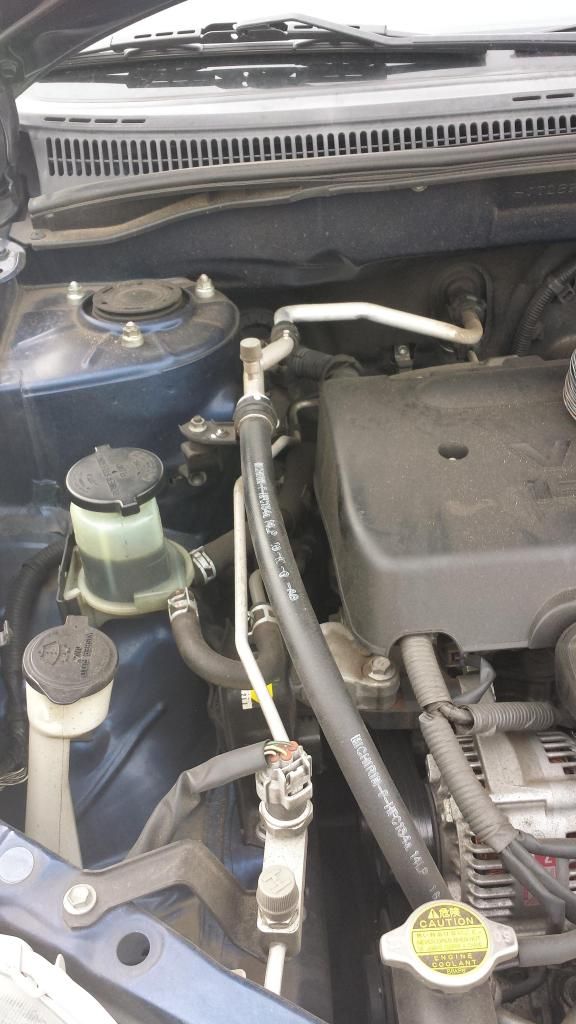
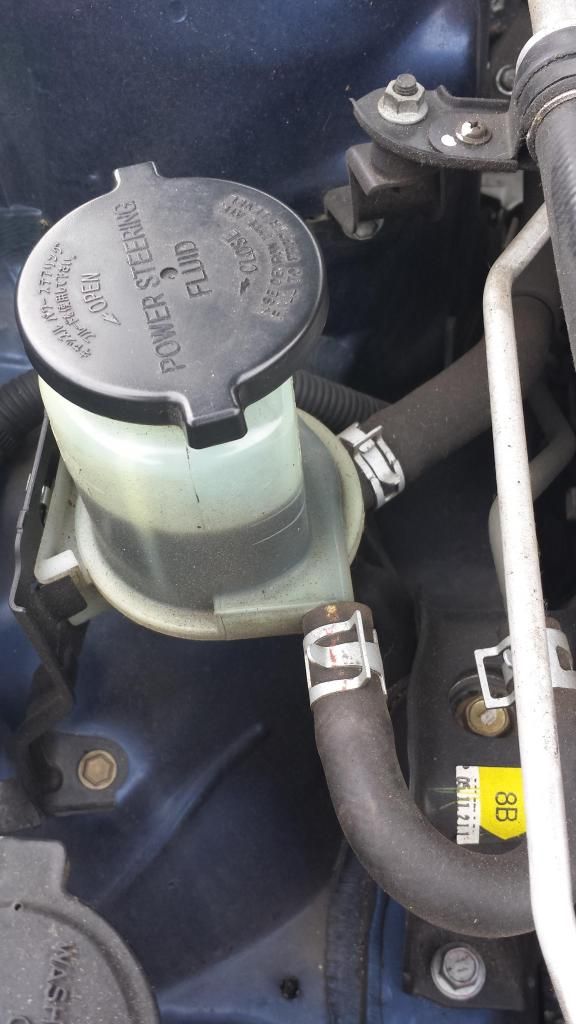
Step 2: Remove the RETURN hose from the reservoir. Prevent fluid from exiting the reservoir. This can be done using a hose and zip tying it upwards so that the top of the hose is above the reservoir. On my engine, I simply left the U-shaped hose on the reservoir, removed it from the plastic line and routed it upwards. (See picture)
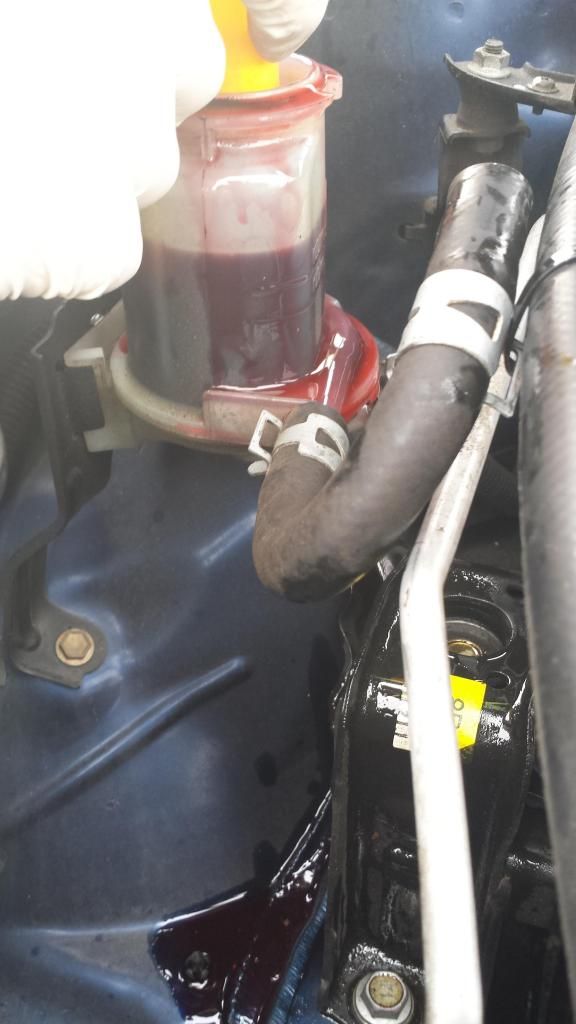
Step 3: Attach 3/8" inside diameter hose to the hard plastic return line. No hose clamps are required. If you are working on another engine with soft hoses all the way to the reservoir, I've found that a 3/8" Inside diameter clear plastic fuel line works great (found in the small engine section of your local auto parts or hardware store).
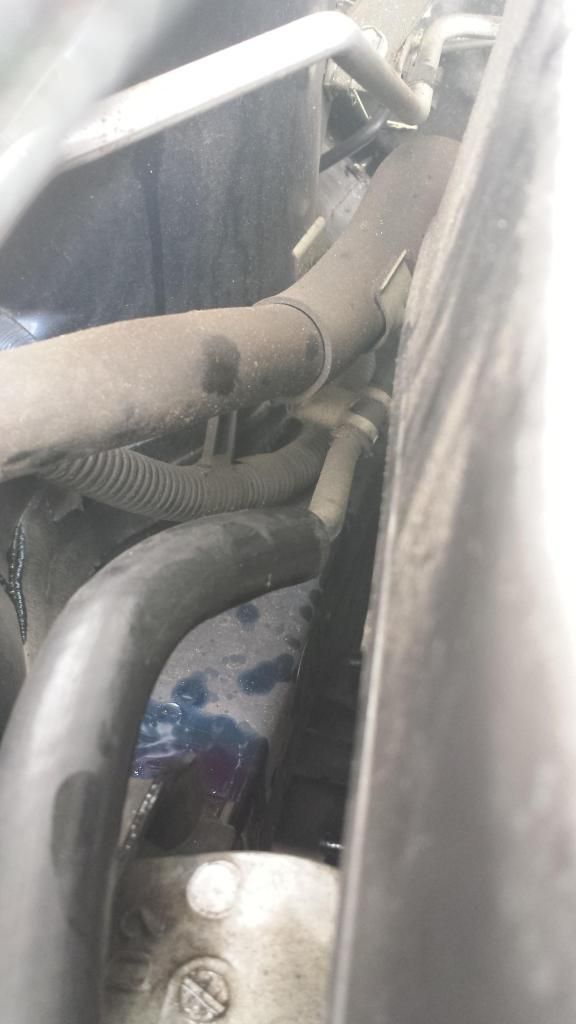
*Note: I only had a 1/2" hose and was too cheap/lazy to go buy a 3/8" hose. I made an absolute mess. Don't be like me, get the right size hose .
Step 4: Route the hose that you just attached in step 3 to the drain pan on the ground.
Step 5: Start engine, let run for maybe 1 second, shut off engine. Top off your reservoir. *YOU DO NOT WANT TO LET YOUR RESERVOIR GET EMPTY with the engine running as this can damage your P/S pump.
Continue step 5 over and over until the fluid going into the drain bucket looks like the fluid you are putting in.
Step 6: Remove the hose installed in step 3 and reinstall the hose that you installed in step 2 (put the vehicle back to the way you found it).
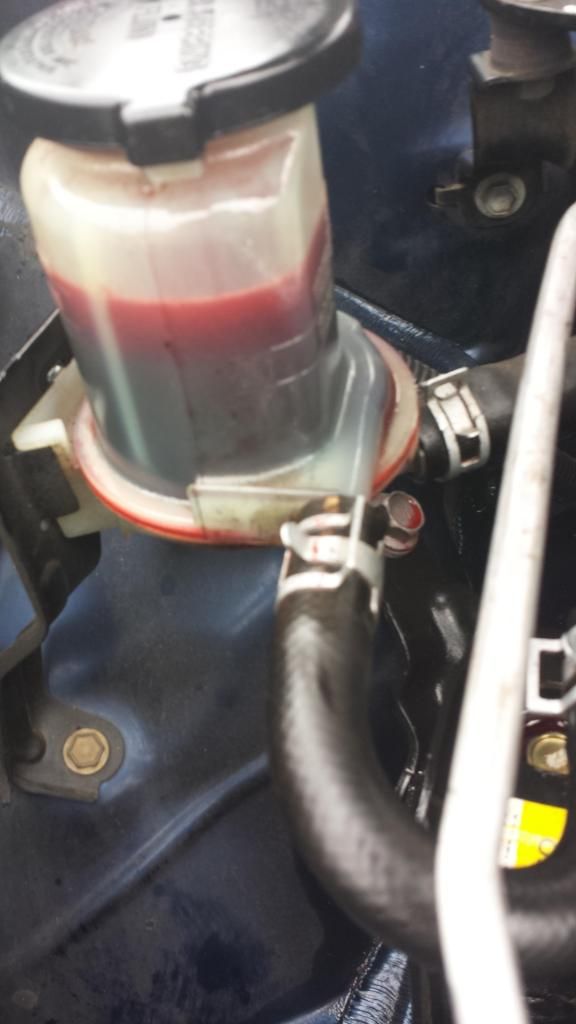
Step 7: Start engine and SLOWLY turn the wheel with the cap off of the reservoir. Ensure that the reservoir does NOT go empty during this time, your fluid level may drop while turning, if it does then add fluid. Turn the wheel lock to lock a few times. Note that when your steering wheel hits the lock, fluid may shoot out of your reservoir, it is best to have someone hold a rag over the reservoir when you near the lock.
Step 8: Do steps 2 and 3 again.
Step 9: Continue to flush the fluid until it looks the same going out as it does going in once again.
Step 10: Put the vehicle back to the way it was when you found it and top off the fluid after driving it around the block.
Why this works: Your vehicle's P/S system is very simple. All you need to know is that it has a reservoir which feeds fluid to a pump. That pump pushes the fluid through the P/S system. There is a return hose that goes from your P/S system back to the reservoir. You are using the vehicle's P/S pump to push the fluid through the system and out the return line into a bucket.
Independent AMSOIL Dealer, Contact me to get the world's best oil for prices lower than brands like Mobil1 and Royal Purple!
GoldMedalSyntheticOils.com
Alrighty, now that I've covered my a**, this guide can begin. I am a professional semi-tractor and trailer (18 wheeler) technician with certifications from both ASE and manufacturers. I also sell AMSOIL to make some side money.
This was conducted on my 2006 Toyota Corolla CE with the 1ZZ-FE engine. At the end of this post, I'll explain how and why this flushes the fluid from the system.
Tools needed to complete this job:
-Drain Pan
-~4 ft 3/8" Inside Diameter Hose (Vacuum hose is cheapest)
-Hose clamp pliers (or slip joints)
-Zip tie
-~2 QTs of fluid. My vehicle uses ATF+3 in the power steering system. I used AMSOIL Signature Series ATF.
-A funnel or good hand-eye coordination
Step 1: Locate P/S Fluid Reservoir. If your reservoir is directly on top of the P/S pump then it will have 1 hose on it. We will call this the return hose. If your P/S Reservoir is external from the pump (like it is on the 1ZZ-FE) then it will have 2 hoses on it (Suction and return). The suction hose is the larger hose, it will also be towards the bottom of the reservoir. The return hose will be above the suction hose and be significantly smaller. Those 2 statements are true for any hydraulic system that has an external reservoir.


Step 2: Remove the RETURN hose from the reservoir. Prevent fluid from exiting the reservoir. This can be done using a hose and zip tying it upwards so that the top of the hose is above the reservoir. On my engine, I simply left the U-shaped hose on the reservoir, removed it from the plastic line and routed it upwards. (See picture)

Step 3: Attach 3/8" inside diameter hose to the hard plastic return line. No hose clamps are required. If you are working on another engine with soft hoses all the way to the reservoir, I've found that a 3/8" Inside diameter clear plastic fuel line works great (found in the small engine section of your local auto parts or hardware store).

*Note: I only had a 1/2" hose and was too cheap/lazy to go buy a 3/8" hose. I made an absolute mess. Don't be like me, get the right size hose .
Step 4: Route the hose that you just attached in step 3 to the drain pan on the ground.
Step 5: Start engine, let run for maybe 1 second, shut off engine. Top off your reservoir. *YOU DO NOT WANT TO LET YOUR RESERVOIR GET EMPTY with the engine running as this can damage your P/S pump.
Continue step 5 over and over until the fluid going into the drain bucket looks like the fluid you are putting in.
Step 6: Remove the hose installed in step 3 and reinstall the hose that you installed in step 2 (put the vehicle back to the way you found it).

Step 7: Start engine and SLOWLY turn the wheel with the cap off of the reservoir. Ensure that the reservoir does NOT go empty during this time, your fluid level may drop while turning, if it does then add fluid. Turn the wheel lock to lock a few times. Note that when your steering wheel hits the lock, fluid may shoot out of your reservoir, it is best to have someone hold a rag over the reservoir when you near the lock.
Step 8: Do steps 2 and 3 again.
Step 9: Continue to flush the fluid until it looks the same going out as it does going in once again.
Step 10: Put the vehicle back to the way it was when you found it and top off the fluid after driving it around the block.
Why this works: Your vehicle's P/S system is very simple. All you need to know is that it has a reservoir which feeds fluid to a pump. That pump pushes the fluid through the P/S system. There is a return hose that goes from your P/S system back to the reservoir. You are using the vehicle's P/S pump to push the fluid through the system and out the return line into a bucket.
Independent AMSOIL Dealer, Contact me to get the world's best oil for prices lower than brands like Mobil1 and Royal Purple!
GoldMedalSyntheticOils.com
